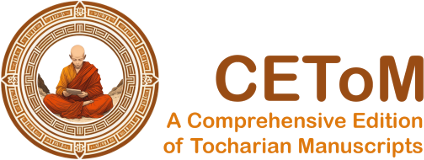PK DA M 507.3
| Known as: | PK DA M 507.3; PK Cp 3 |
|---|---|
| Cite this page as: | Adrian Musitz. "PK DA M 507.3". In A Comprehensive Edition of Tocharian Manuscripts (CEToM). Created and maintained by Melanie Malzahn, Martin Braun, Hannes A. Fellner, and Bernhard Koller. https://cetom.univie.ac.at/?m-pkdam507_3 (accessed 12 Jul. 2025). |
Edition | |
| Editor: | Adrian Musitz |
Provenience | |
| Collection: | Bibliothèque nationale de France, fonds Pelliot Koutchéen (Paris) |
Language and Script | |
| Language: | TB |
Text contents | |
| Text genre: | Non-literary |
| Text subgenre: | Account |
| Verse/Prose: | prose |
Object | |
| Material: | on paper |
| Form: | Scroll |
| Number of lines: | 16 |
Transliteration
| a1 | pi¯ ¯ś kṣuṃ ntsa nai yma ñe meṃ /// |
|---|---|
| a2 | 10 8 to wä 5 /// |
| a3 | śa ktre yne śwa si ṣṣai ysā [r]e /// |
| a4 | śa kñu ne śwa si ṣṣai ysā [r]e /// |
| a5 | cau ko mna¯ ¯k pu tte yā ne ntse /// |
| a6 | i kaṃ tre yne lye kśyi mñai /// |
| a7 | wä 5 i kaṃ o – /// |
| a8 | 8 ñweṃ ne lye [kś]yi /// |
| a9 | me ñe wa te o¯ ¯k me ña ntse /// |
| a10 | me ñe tri te pi¯ ¯ś me ña – /// |
| a11 | 10 |
| a12 | me ñe śta rte pa ka cā ñi /// |
| a13 | wsa¯ ¯m pi śto¯ ¯m 5 /// |
| a14 | śa¯ ¯k me ña ntse ne sa ṅka – /// |
| a15 | 6 to wä pi śto¯ ¯m 5 pi· /// |
| a16 | tsa ñi /// |
Transcription
| a1 | piś kṣuṃntsa naiymañe meṃ(ne) /// |
|---|---|
| a2 | 10-8 towä 5 /// |
| a3 | śakn1 treyne śwasiṣṣai ysāre /// |
| a4 | śak ñune śwasiṣṣai ysāre /// |
| a5 | cau komnakn2 putteyānentse /// |
| a6 | ikäṃ treyne lyekśyimñai /// (to)¬ |
| a7 | wä 5 ikäṃ o(kne) /// |
| a8 | 8 ñweṃne lyekśyi(mñai) /// |
| a9 | meñe wate ok meñantse /// |
| a10 | meñe trite piś meña(ntse) /// |
| a11 | 10 /// |
| a12 | meñe śtarte pakacāñi(ś) /// |
| a13 | wsam piś tom 5 /// |
| a14 | śak meñantsene saṅka(ntse) /// |
| a15 | 6 towä piś tom 5 pi(ś) /// |
| a16 | tsañi /// |
Translation
| a1 | In the fifth regnal year in the first month... |
|---|---|
| a2 | (piculs) 18, pecks 5. |
| a3 | On day thirteen, grain for consumption... |
| a4 | On day fourteen, grain for consumption... |
| a5 | On the same day, Putteyāne ... |
| a6 | On day twenty three, lyekśimñai ... |
| a7 | ... pecks 5. On day twenty eight... |
| a8 | ... 8. On the last day, lyekśimñai... |
| a9 | Second month. On day of the month five, ... |
| a10 | Third month. On day of the month three, ... |
| a11 | 10 |
| a12 | Fourth month. For pakaccāṃn3 ... |
| a13 | We gave... five pecks 5. |
| a14 | On day of the month ten, of the saṅgha... |
| a15 | 6 pecks, five pecks 5 five... |
| a16 | The Tsañin4 ... |
Commentary
Philological commentary
| n1 | It looks like the scribe first wrote 'kñu', but then corrected the akṣara. |
|---|---|
| n2 | Likely komnak instead of **komtak. komnak would make more morphonological sense: *kaunak to komnak is the same kind of change as in larauñe to laromñe (cf. also komne in PK DA M 507.27 b3). komtak on the other hand is completely intransparent. |
| n3 | pakaccāṃ is a difficult word. Isebaert 1978: 344-345 considers it to be a loan from Sanskrit *upagacchana, an equivalent of upanāyikā-, denoting the 'entering', i.e. beginning, of vassa. Pinault 1994b: 96 also connects this word to vassa and alleges that it originates from Sanskrit *bhakta-chedana-, an equivalent of bhakta-chinnaka 'fasting'. Ching 2017: 222-228 argues that pakaccāṃ did not originally denote vassa itself, but a particular kind of action a dānapati performs, namely promising to supply the monastery for 3-4 months, coinciding with vassa. She shows that there were two periods of pakaccāṃ, one in the later third of the fourth month and one in the middle of the last month. The old turkic equivalent is b(a)kcan, cf. Zieme 1981: 254-262, the Sogdian pkc'n, cf. Ching 2017: 228. |
| n4 | The Tsañi is a kind of monastery functionary, cf. the 'Findings'-section. |
References
Edition
Ching 2010: 193-194, 461; Ching 2017: 222-228; Pinault 0000: 2-4; Pinault 1994b: 96; Isebaert 1978: 344-345; Zieme 1981: 237-263
Bibliography
Ching, Chao-jung. 2010. “Secular documents in Tocharian: Buddhist economy and society in the Kucha region.” PhD, Paris: École Pratique des Hautes Études.
Ching, Chao-jung. 2017. 吐火罗语世俗文献与古代龟兹历史 – Tocharian secular texts and the history of Ancient Kucha. Beijing: Peking University Press.
Isebaert, Lambert. 1978. “Notes de lexicologie tokharienne IV.” Orbis: bulletin international de documentation linguistique 27: 344–47.
Pinault, Georges-Jean. 0000. “Textes économiques koutchéens.”
Pinault, Georges-Jean. 1994b. “Aspects du bouddhisme pratiqué au nord du désert du Taklamakan, d’après les documents tokhariens.” In Bouddhisme et cultures locales. Quelques cas de réciproques adaptations. Actes du colloque franco-japonais de septembre 1991, edited by Fumimasa Fukui and Gérard Fussman, 2:85–113. Études Thématiques. Paris: École française d’Extrême-Orient.
Zieme, Peter. 1981. “Uigurische Steuerbefreiungsurkunden für buddhistische Klöster.” Altorientalische Forschungen 8 (237-264).


